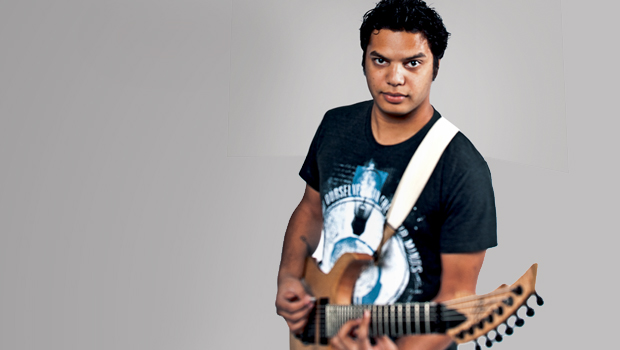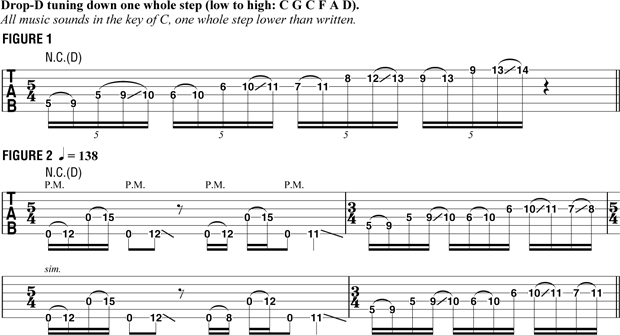The Djent Set: Marrying Opposing Musical Ideas, Plus How to Play the Intro to “Buttersnips”

Over the course of the next few months, I’d like to share my approach to songwriting within the context of my band’s self-titled debut album, Periphery. Specifically, we’ll look at the ways in which I combine unusual chordal patterns and single-note riffs in the quest to create new sounds and unearth fresh musical concepts and ideas.
When it comes to describing my approach to songwriting, a good place to start is the song “Buttersnips.” The intro itself offers a good example of how I try to meld different aspects of my influences as a musician and guitar player. When it comes to writing riffs, if I have two opposing licks that I like a lot, I’d rather put them together than have to choose between them. That, in turn, creates the effect of two riffs of different styles fighting each other for attention, which adds a degree of tension to the music that really appeals to me.
Whether it’s in regard to a syncopated chord part or a single-note line, I like everything to maintain a clear sense of melody and create the impression of forward motion as well as resolution. I don’t like to simply collect different riffs and string them together in either a chronological or random way with no regard for the broader musical picture.
Before we begin breaking down the guitar parts to “Buttersnips,” I should point out that in Periphery we use both six- and seven-string guitars and employ drop tunings. For “Buttersnips,” my guitar is tuned to drop-D down one whole step (low to high: C G C F A D).
The “Buttersnips” intro begins with a repeating low-note pattern played over a grinding half-time groove, followed by a quickly ascending, atonal single-note line that reveals the influence of jazz-fusion guitarist Allan Holdsworth, who is one of my biggest inspirations. “Buttersnips” begins with a very Holdsworth-like five-note riff, illustrated in FIGURE 1. It’s built from wide, two-whole-step hammer-ons, followed by a half-step slide on ascending pairs of strings. I start on the fifth and fourth strings and then move over, and up one fret, to the fourth and third, third and second, and second and first strings. The riff begins with the index finger on D, fifth string/fifth fret, followed by a hammer-on with the pinkie to Fs at the ninth fret. This hammer-on shape is repeated one string higher, followed by a slide with the pinkie, from B on the fourth string’s ninth fret to C at the 10th fret. The pattern is then repeated, albeit one fret higher, on each higher pair of strings.
In FIGURE 1, I’ve notated the five-note pattern as quintuplets (five-note groups) for the purpose of illustration, but I actually play the phrase in straight 16th notes within the context of the song, which creates a cool and unusual syncopation and melodic contour.
FIGURE 2 shows the song’s main intro riff, starting with a low-note figure that “bounces” the open sixth and fourth strings with notes hammered high onto on the fretboard. In this example, bar 1 is notated in 5/4 meter. In bar 2, written in 3/4, I play the previously shown climbing single-note riff, but here it is presented as straight 16ths.
When you combine one bar of 5/4 with one bar of 3/4, you end up with eight quarter notes over two bars, which is the same as two bars of 4/4. In order to make these two ideas sit over that “eight beats across two bars” framework, I had to cut off the end of the climbing lick in bar 2. The first time I play the lick, I end with a half-step ascending slide from D to Ef. The second time, I hammer-on from D up two whole steps, to Fs.
Another twist is offered in bar 3: across beats three and four, I move the hammer-ons down on the neck, hammering on to the eighth fret on the sixth string and to the 12th fret on the fourth string.
In combining these opposing licks, my goal is to create a certain feel and mood by improvising around these different fretboard shapes and patterns.
I’ll be back next month with more on “Buttersnips” as well as a look at my primary guitar influences. See you then.

Get The Pick Newsletter
All the latest guitar news, interviews, lessons, reviews, deals and more, direct to your inbox!









